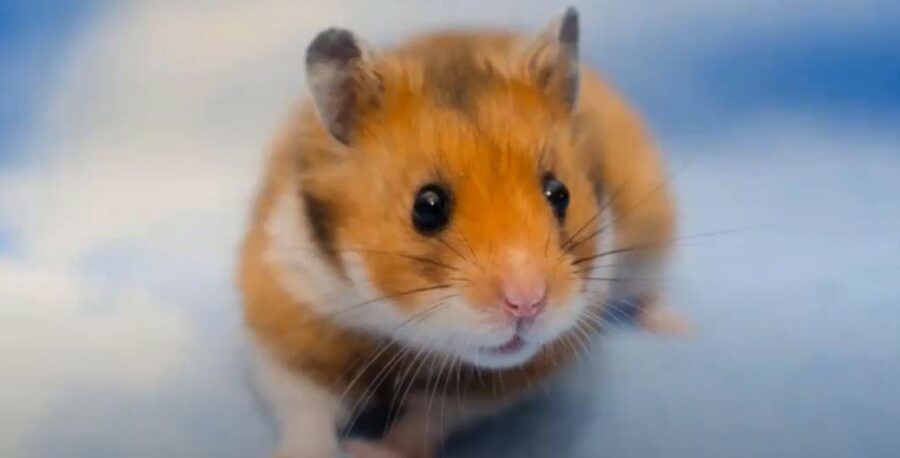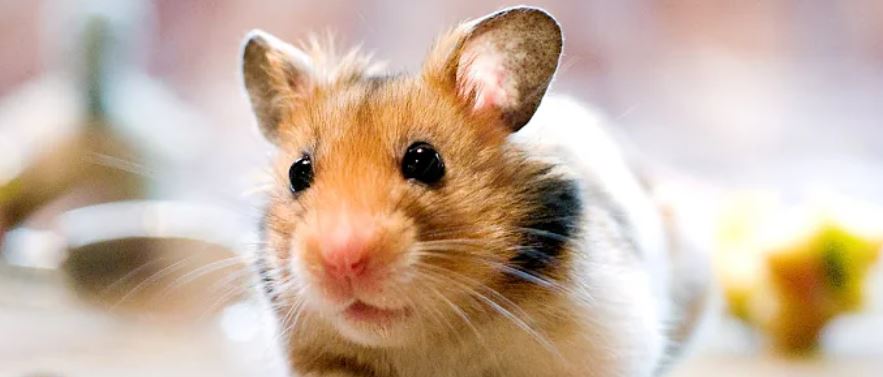I see my hamster looking at me, but can she really see me? Are hamsters color blind? How strong is a hamster’s vision?
Can my hamster see what’s going on outside or on TV? Do you want to know more about color blindness?
In this article we’ll focus on hamster vision and find out if they are color blond.
Are Hamsters Color Blind?
Yes. Since their eyes have more than 97% rod cells and only 3% cone cells, hamsters are color blind. However, they can still perceive hues that are in the green region of the electromagnetic spectrum.
They can only see in colors of:
- grey
- black
- white
- very light tints of green and blue
Hamsters have more rod-shaped cells in their eyes than daytime active animals. They can see in low light thanks to their rod function as sensors.

Why Hamsters Are Color Blind
The quantity of rod and cone cells in hamsters’ retinas is the primary factor causing their color blindness. Hamster retinas have around:
- 97% rod
- 3% cone photoreceptors
Its rod and cone population density is comparable to that of a mouse. Certain colors are visible to hamsters. Hamsters can see certain colors since they do have some cone cells in their eyes.
According to research, Syrian hamsters are colorblind and can perceive various shades of green.
Are Hamsters Near-sighted?
Yes. Hamsters lack a decent sense of distance since they are nearsighted in addition to being color blind.
They are able to see what is in front of them, but they have limited peripheral vision. As hamsters also have poor height perception, they would joyfully wander off ledges without considering how far they may fall.
Because of this, it’s crucial to hold your hamster while doing so from a secure height in case they leap. For the same reasons, it’s also suggested to avoid raising the platforms in your hamster’s cage.
Do Hamsters See At Night?
Yes. Hamsters switch between being entirely nocturnal and crepuscular, meaning that they are most active at dawn and twilight when there is little to no natural light.
Outside of these times, they spend the majority of their time resting, feeding, or constructing their nests in their burrows. They create quarters for themselves in the burrows, which are connected by networks of tunnels that they may enter from above ground.
- Because there are fewer predators at night, hamsters’ eyesight has evolved to function best then. A wild hamster seldom makes an appearance above ground during the day.
- Hamsters are able to see much better in the dark than humans can because they have more rod receptors, which increases the amount of light that is absorbed into the retina.
- However, hamsters do require some light to see. Hamsters do best in low light situations like dawn or dusk, although they cannot see very well in complete darkness.
Since hamster burrows, in particular, are very dark, they primarily rely on their keen sense of smell and memory to get around.

Does My Hamster See Me?
Yes. When their owners are near the cage, hamsters can see you, but they mostly rely on their senses of hearing and scent.
It’s best to alert your hamster to your presence before picking them up or reaching inside their cage. They will recognize you and understand that you are not a threat if you speak to them gently.
Similarly, to avoid your hamster from being surprised when you hold them, give them a chance to see and smell your hand first.
Be careful to wash your hands before touching your hamster because they only bite when they are startled or mistake your finger for food due to their poor vision.
Do Hamsters Need A Light At Night?
No. A nightlight is not necessary for your hamster to navigate their environment. It is preferable to set up your hamster’s cage so that it may follow the natural cycle of day and night.
Keep artificial lighting to a minimum, and allow your hamster to rest and feed in accordance with its natural circadian rhythm.
Like the majority of nocturnal creatures, hamsters can see better in dimly lit areas than in bright ones. A hamster is entirely blinded by sunlight or spotlights like those from a flashlight, so you must constantly provide your small pet with dark spaces to hide and sleep.
Hamster Vision Explained
According to research on hamster eyesight, their vision is around 20/2000. Any human with a vision of 20/200 or worse is considered legally blind.
They will never truly be able to appreciate a faraway scene or enjoy watching television. Because of their extreme nearsightedness, hamsters can only distinguish shapes that are right next to their nose.
When delectable treats are disguised, they can locate items with the help of their perceptive whiskers and sharp vision.
By creating a maze and hiding some treats inside the tunnels, you may test your hammie’s sense of direction. Your tiny pet will discover its way by sniffing the air and moving forward in search of the buried treats.

What Causes Color Blindness?
The following may contribute to color blindness:
- Missing cone cells
- Cone cells are harmed
- Color cannot be detected by cone cells
The eyes include cone and rod cells. Cone cells perceive colors and respond to them, whereas rod cells detect dark and light. Green, blue, and red cone cells are the three different varieties.
Cone cells recognize color and transmit a signal to the brain, which aids in the brain’s ability to recognize color.
One of the three cone cells can stop functioning, resulting in mild color blindness, whereas damage to all three cone cells being red, green, and blue results in severe color blindness.
Do Hamsters Need to See Colors?
No. Animals active at night include owls, bats, foxes, guinea pigs hamsters. Animals classified as nocturnal are those that sleep during the day and are active at night.
The majority of nocturnal creatures are color blind, much like hamsters are. The reason why hamsters prefer to venture outside at night is very clear. They don’t want to be captured by their predators and eaten.
The tiniest chance exists that hamsters would require the ability to detect colors is at night. Strong concealment abilities and the ability to locate food would be far more important to them.
They can locate food and return to their habitats with the aid of their keen hearing and smell senses.
- hearing
- smelling
- whisking
These actions allow them to stay safe and navigate in the dark.
Do Hamsters Have Good Eyesight?
No. A hamster’s spatial vision is relatively limited, and this is due to how far apart its eyes are from one another. As a result, individuals have trouble seeing far-off things.
Due to their short sight, hamsters can only see objects that are sharper and closer to them. They are equivalent to humans in that they have 20/400 vision. You can now understand the challenge they face.
Their rounded eyes enable them to locate a large region surrounding them. Even when predators are coming at them from the side, this feature along with a strong sense of smell, enables them to escape.

Are Hamsters Blind?
No. Hamsters are not blind. .They do have strong eyesight, but not as keen as some other creatures.
Small eyes positioned on the sides of the head give hamsters a wide field of vision but lessen their ability to perceive depth. Additionally, they have trouble distinguishing colors and they see best in dim lighting.
Can Hamsters Recognize Their Owners?
Yes. Hamsters recognize owners. Hamsters may not be as smart as dogs or cats, but they may link their owners with pleasurable events like being fed or played with.
Hamsters can smell their owners. They also recall regular handlers. Hamsters may recognize their owners by approaching, requesting attention or food, seeming relaxed and comfortable.
Not all hamsters are sociable or comfortable with humans. Some hamsters are shy or independent and take longer to bond with their owners. It’s crucial to be patient and respectful of their interests and personalities.
Conclusion
Hamsters are colorblind and their eyes lack color-sensitive cells. While hamsters have excellent low-light vision, their inability to perceive colors is important when designing their living environments and choosing toys and accessories.
By knowing more about their vision, we can provide our pets the finest care and assure their pleasure and well-being.
Thank you for visiting PocketPetCentral.com for the best information to help you enjoy the life of your pocket pet companion in a fun, safe & healthy way.


